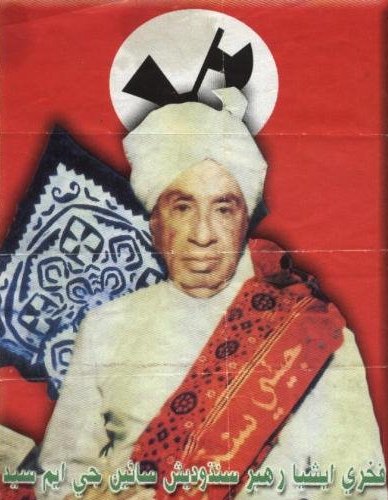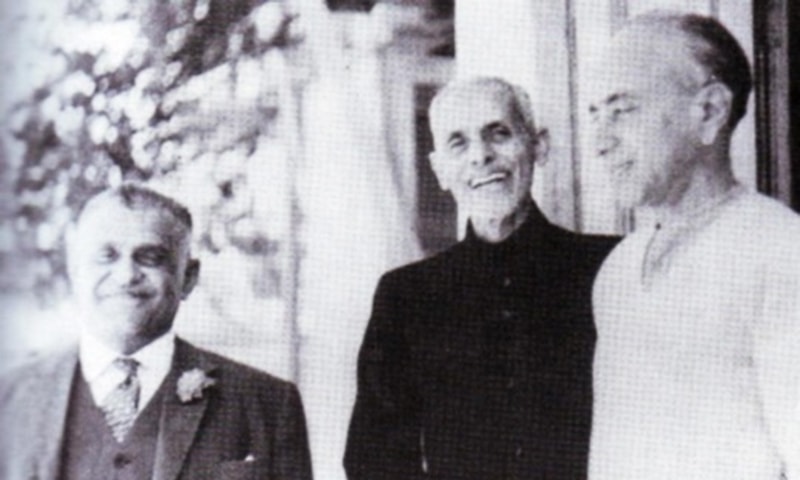
Ghulam Murtaza Syed, also known as G. M. Syed, was an influential Sindhi politician and is considered as the founder of Sindhi ethno-nationalism. He had formed Sindh Progressive Party in 1947. The main purpose of the organisation was to oppose the Two Nation Theory and to advance the struggle for provincial autonomy within a socialist framework.

In 1953, he formed a political alliance called Sindh Awami Mahaz. It consisted of four parties: Sindh Awami Jammat, Sindh Jinnah Awami League, Dastoor Party and Sindh Hari Committee. The Sindh Awami Mahaz later went on to join National Awami Party, another political alliance of various leftist and progressive political groups. National Awami Party was a major leftist political force in East and West Pakistan. NAP opposed Pakistani military regimes for much of the late 1950s and mid-1960s. In 1967 the party split into two factions, one in East Pakistan and another in West Pakistan.
The Jeay Sindh movement came into being in early 1970s. It consisted of a cluster of organisations under different names. The word “Jeay Sindh” was first time used by G. M. Syed in one of his poems. The main stated motive of these organisations was to protect Sindhi culture and language. After Bangladesh became independent in 1971, G.M. Syed gave a new direction to Sindhi nationalism and founded the Jeay Sindh Mahaz (JSM) in 1972 and presented the idea of Sindhudesh; a separate homeland for Sindhis.

G. M. Syed argued that “Pakistan is the bastion of Punjabi-Mohajir imperialism where Sindhis can never hope for their due share”. The main reason was Sindhis were under-represented in bureaucracy and in the armed forces of the country. He believed that Sindhis are a separate nation – with their own language, culture, customs and homeland and that Islam is merely a legitimising ideology, a cloak of domination for other nationalities. The leaders of the movement expected Soviet Union and India to help them in their fight against the Pakistani state because of their socialist worldview and the enmity between India and Pakistan, respectively.
The Sindhi nationalist movement’s demands ranged from greater cultural, economic and political rights, to political autonomy, and to outright secession from Pakistan and the creation of an independent state called Sindhudesh. Later JSM divided into multiple factions. Majorly, two of these various political counterparts of Sindhi nationalism are Jeay Sindh Qaumi Mahaz (JSQM) and Jeay Sindh Muttahida Mahaz (JSMM), both of which advocate for Sindhudesh.
Dr. Arbab Khuhawar, a Marxist activist in the Jeay Sindh camp, was the first person to part ways with Syed, saying the nationalist movement should have a more socialist leaning. In 1979, Khuhawar formed the Sindh Watan Dost Party, based on hardcore socialist ideology. His party played an active role in the 1983 Movement for the Restoration of Democracy but eventually disappeared from the political scene.

Initially, the Jeay Sindh movement was divided mainly into two groups, one led by Dr. Hameeda Khuhro and another by Abdul Wahid Arisar. The one led by Dr. Khuhro was dominated by feudal lords, while Arisar and others came from the working or middle class, who were ideologically socialists and admired socialist national liberation movements and wanted to make the Jeay Sindh movement a representative of the common man. The other faction, Jeay Sindh Mahaz (JSM), was further divided into two groups led by Bashir Khan Qureshi and Arisar in the early nineties. Syed’s death in 1995 brought all factions of Jeay Sindh under one umbrella and the Jeay Sindh Supreme Council was formed. However, a faction led by Khaliq Junejo did not join this merger and continued to work under the banner of the JSM. Later, groups led by Arisar and Qureshi formed the Jeay Sindh Qaumi Mahaz (JSQM) in 1995. Arisar and Qureshi parted ways over political differences in 1999. The main point of disagreement was Arisar’s sympathies for an organisation working for Mohajirs (Sindh’s Urdu-speaking settlers).
Among the Jeay Sindh factions, the JSQM became more popular among Sindhi nationalists. Qureshi, who hailed from Naudero, was an active member of the Jeay Sindh Students Federation (JSSF) at the Sindh Agriculture University in Tando Jam during his student years.
Qureshi was able to shift the centre of Sindhi nationalist politics from Hyderabad to Karachi. His death under mysterious circumstances in April 2012, followed by the death of his brother Maqsood, who was made his successor in the party, weakened the group.
Since then the leadership of this faction has been handed over to Bashir’s son Sanaan, a youngster who lacks political training and experience and therefore lacks credibility in nationalist circles.
In Sindh province many nationalist parties other than these separatist nationalist parties have been demanding for the rights of Sindhi people according to the Lahore Resolution of 1940 within the framework of the constitution of Pakistan. Major parties that advocate this narrative are Awami Tehreek led by Rasool Bux Palijo, Sindh United Party led by G. M. Syed’s grandson Syed Jalal Mehmood Shah and Sindh Taraqi Pasand Party led by Qadir Magsi.
Though G. M. Syed opposed parliamentary politics after the 1970 elections, his family members did not. Both of us his sons Syed Imdad Mohammad Shah and Syed Amir Haider Shah were elected MPAs in 1985 and 1992, respectively. His grandson Syed Jalal Mahmood Shah has regularly been contesting elections since the 1990s and leads the Sindh United Party.
Another Sindhi nationalist group, the Jeay Sindh Muttahida Mahaz (JSMM), believes in armed struggle. Though it lacks popularity among Sindhi nationalists, it has managed to expand its reach to universities. Bomb blasts attributed to the banned JSMM by the police have been reported at intervals in different parts of Sindh. Several of its members have also gone missing and some of their mutilated dead bodies have been found later.
The Sindh Taraqqi-pasand Party (STP), formed by Dr Abdul Qadir Magsi in the early nineties, initially believed in achieving its goals through armed struggle. Dr Magsi was critical of Syed’s strategy of boycotting parliamentary politics, stating that it caused loss to the nationalist movement. Dr Magsi, who hails from Thatta, gained popularity after the Jeay Sindh Students’ Federation (JSSF) clashed with the New Sindhi Organisation, a students’ body of Punjabi settlers. This faction initially gained popularity due to its militant stance in the 1990s but its fortunes have dwindled over the years.
The Sindhi nationalists have been unable to fill the political vacuum in Sindh created by years of bad governance by the Pakistan People’s Party (PPP), which is the ruling party in Sindh most of the time. For instance, the nationalists were missing from the scene during the 2010 flooding and the later drought in Thar. Due to the absence of a viable strategy, the Sindhi nationalist groups have been reduced to pressure groups instead of effective political groups.
In 2014, Sindh Bachayo Committee (SBC) which included representatives of the Jeay Sindh Qaumi Mahaz, Sindh United Party, Jeay Sindh Qaum Parast Party and Awami Jamhoori Party started agitation against the arrival of migrants and IDPs to Sindh.
Sindhudesh Revolutionary Army (SRA):
The ethno-nationalist militancy in Pakistan is mainly divided into two provinces: Balochistan and Sindh. As of now, we will focus on Sindhi separatist groups. There were two well-known Sindhi nationalist militant groups: Sindhudesh Liberation Front and Sindhudesh Liberation Army. Sources in Pakistan claim the Sindhudesh Liberation Army is working under the leadership of self-exiled Shafi Muhammad Burfat. Burfat is reportedly living in Germany from where he attempts to control the movement.

The Sindhudesh Revolutionary Army came into being in 2010 after fallout within elements of Burfat-led-SLA. Syed Asghar Shah (a resident of Jamshoro, Sindh) was a close aide of Shafi Muhammad Burfat but they split on the issue of funds and influence as Burfat was living in a foreign country and Shah was on the ground. Asghar Shah’s family disassociated themselves from him in July 2020 after 3 explosions in Karachi, Larkana and Ghotki killed 4 people including 2 soldiers in a series of attacks claimed by SRA. The family said that Asghar Shah was hiding in Afghanistan and was the mastermind behind all the attacks.
The website of SRA claims that they are “fighting for free, sovereign, secular and democratic state of Sindhudesh”. The group has claimed responsibility for several attacks against Pakistani Armed Forces: Army, Rangers as well as Chinese professionals. The group is also responsible for attacks against supply lines, high transmission lines, gas and oil pipe lines in Karachi, Sukkur and other cities of Sindh province.
SRA claims that they have also attempted attacks against religious militant or extremist organisations like Lashkar-e-Taiba, Jamaat-ud-Dawaa etc. in Karachi, Hyderabad, Larkana and other cities of Sindh. SRA believes these groups “operate at the behest of Pakistani state institutions and are a threat not only to Sindh’s secular nature and harmony but also to regional and international peace and security”, as it states on its website.
According to its website, SRA is working under the command of Sufi Shah Inayat, while a man named Sodho Sindhi is the spokesperson of the group.
Recent attacks claimed by SRA:
1) On 28th April 2022 – Sindhudesh Revolutionary Army took responsibility for two attacks: (a) A High Transmission Line was blown in Bholari, Kotri, Jamshoro district & (b) a railway track was blown up at Junghshahi station, Thatta district.
2) On 26th April – The group claimed blowing up a railway track at Bandhi station, near Nawabshah city, Shaheed Benazirabad District.
3) 15th April – 2 power pylons were blown up with explosives near Jhokar, in the vicinity of Rashid Vigan police station in Larkana.
4) 10th April – A railway track was blown up at Kotri railway station in Kotri city, Jamshoro district.
5) 5th April – A railway track was blown up near Padidan town in Naushahro Feroze district.
6) 31st March – Two railway tracks were blown up in Khursheed Colony in Kotri town, Jamshoro district and near Detha railway station in Hyderabad rural taluka. Meanwhile, on 6th April, acting on a tip-off, the Hussainabad police arrested 3 alleged SRA militants. They were identified as: Manzoor Ali Shar, Qurban Ali Shar and Manthar Ali alias Pappu Shar. IEDs and several other devices were recovered from their possession.
7) 25th January – A “Punjabi settler & alleged Pakistani intelligence agent” (identified as: Yousuf Arain) was targeted and injured in a gun attack at Sindhri-Mirpurkhas road.
Apart from the attacks on infrastructure, SRA militants have also targeted foreign nationals. In December 2020, a Chinese national and his interpreter survived a gun attack in Karachi. A week before, on December 16th 2020, two SRA militants fled on a motorcycle after placing a Magnetic Improvised Explosive Device (MIED) on the vehicle of Chinese national in Clifton, Karachi. The MIED failed to detonate.
Claiming responsibility for both attacks, the group in a statement said, “China and Pakistan have forcibly been occupying the land under the projects of the China-Pakistan Economic Corridor (CPEC) and we will continue our attacks to target them.”
Linkages between SRA and Baloch militant groups:
In 2020, BRAS (Baloch Raji Ajoi Sangar – a conglomerate of four Baloch ethno-nationalist militant groups) established an alliance against CPEC – the China-Pakistan Economic Corridor – with the Sindhi separatist group, Sindhudesh Revolutionary Army (SRA). On 25th July, 2020 – Baloch Khan, spokesperson for Baloch Raji Ajoi Sangar (BRAS), in a statement released to the media said that, “Sindh and Balochistan are equally affected by the expansionist and oppressive resolves of China. Through the China Pakistan Economic Corridor (CPEC), China aims to subjugate Sindh and Balochistan and occupy the coasts and resources from Badin to Gwadar.”
The development was not something new but the statement confirmed the existing links between Baloch and Sindhi militant groups. The announcement came in the wake of an attack carried out by 4 BLA militants on Karachi Stock Exchange on 29th June 2020 with the help of SRA. 7 people (4 attackers, two guards and a policeman) were killed in the attack according to official figures. The BRAS-SRA alliance has provided the militant groups a common platform against a new target, aside from the Pakistani state and security institutions — CPEC.
In the past, Sindhudesh Liberation Army (SLA) – another Sindhi nationalist militant group – had reportedly collaborated with Baloch militant groups the BLA and the BLF in targeting Chinese nationals. The collaboration was not restricted to Pakistan only, but also extended to Afghanistan.
Recently, on 26th April, three Chinese nationals and their Pakistani driver were killed in a suicide bombing at Karachi University, outside Confucius Institute (a Chinese culture and education outreach centre supported by the Chinese Ministry of Education). The Baloch Liberation Army (Majeed Brigade) took responsibility while also claiming that the attack was carried out by a female suicide bomber, identified as Shari Baloch. Judging by their past links, it cannot be discounted that the suicide bomber or her facilitators could have received some support from SRA for this operation. However, it remains up to the Pakistani investigators to provide further details about the attack which could confirm or reject this possibility.
